NUGEN Audio, in case you’re not familiar, have been making sizable inroads in the post-production and mastering worlds over the last 16 years with plug-ins that I generally characterize as problem-solving tools. However, in the last few years, they have also begun to focus on music production and mixing solutions, with products like SigMod [Tape Op #127], Stereoizer, and Stereoplacer. I’ve used many of NUGEN’s plug-ins for several years and rely on their MasterCheck, Visualizer, and ISL (inter-sample limiter) when I’m mixing or mastering for broadcast, so I was excited when they announced a newly updated version of SEQ-S earlier this year because I knew they would take a novel approach to equalization. This plug-in is still firmly set in the problem-solving category – but isn’t that what we do when mixing anyway? Take away what doesn’t work and leave only the good stuff! There’s no analog modeling or Neve/Pultec/ API/SSL/etc. inspired curves here. SEQ-S is an unabashedly digital – with a capital “D” – linear-phase equalizer.
Being linear-phase, SEQ-S does its best to not smear the phase at points where frequencies are boosted or cut. While equalization is, at its simplest, raising or lowering the volume of a frequency or set of frequencies, doing so introduces phase shift around the center frequency; this leads to a perceived shifting in time of the surrounding frequencies, and thus a smeary, less-than-accurate sound. Granted, this phenomenon is what gives analog EQs much of their sound character, but when going for a more analytical approach, linear-phase EQ can be an incredible tool.
SEQ-S has three independent EQ curves (or Envelopes, as NUGEN calls them) available at a time. These can process any of the available channels on a track in your DAW – L, R, L/R, Mid, Side, or any channel in a surround configuration. This means you could have individual Envelopes processing each of the left and right channels on a stereo track independently, and then a third lifting only the sides for some airy width. Each Envelope also has high- and low-pass filters, plus high and low Zones, which provide brackets within which the frequencies can be adjusted without mistakenly changing any outside of the Zone. The range of the Zone can also be inverted with the Exclude button.
What really sets the SEQ-S apart from most other EQ plug-ins is how the Envelopes are generated. Rather than the more common, limited number of bands from which the eventual EQ curve is derived, NUGEN creates the Envelopes via Splines or a collection of nodes/control points spread between 20 Hz and 20 kHz – there are six options of nodes or Banding as it is labeled in the plug-in’s GUI. There is a 1/3-octave option, a 1/6-octave option, a chromatic interval, and three Banding modes based on the Bark scale where the bands are closer together in the midrange – also where our hearing is more sensitive to frequency changes. The fewest number of nodes in the Banding modes is 26 and all the way to 119 in the Chromatic mode. The curve can be created by boosting or cutting single nodes at a time or by dragging the cursor across the Envelope line in the Direct-draw Zone. This makes it simple to actually draw in the curve you’d like to apply to a track.
There’s also the ability to Morph between two states of the EQ; this can be free-running or synced to the BPM of your DAW. The Morph can run just once, or from the A to the B state (and back again), or loop continuously. This can provide for some cool, tempo-locked filter sweeps, or shifting tonal characteristics on a track that would take much more forethought (or multiple plug-ins) to automate if you didn’t have SEQ-S.
As if all of that weren’t enough, SEQ-S also provides for Match EQ, used to analyze the frequency response of one signal and apply it to another. This can be a lifesaver for vocal tracks that need to sound cohesive and consistent but may have been recorded in different rooms or on different microphones (or both!). Another way to use Match EQ, for example, would be to take the spectral character of a snare drum track (that you love the sound of) and apply it to one that is less-than-inspiring – this could at least help get you in the ballpark.
I imagine you may be thinking, “Does the world really need another EQ plug-in?” I have to say absolutely, given all of the options on offer with SEQ-S! This is some powerful stuff that falls into the genius utility plug-in category. NUGEN offers a fully functional demo, so you should give it a go on your own material. If you never envision needing the multi-channel capability of the plug-in, there’s a mono/stereo-only version available for $100 less. Highly recommended!
Buy From Sweetwater
Buy From Vintage King
Buy From Reverb




_disp_horizontal_bw.jpg)